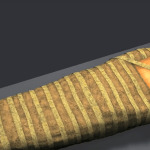Scientists managed to make a computer visualization of the image of a boy who died between 50 and 100 CE. in Egypt, then under Roman rule.
Using a computer tomograph, it was possible to upload a virtual 3D reconstruction of the boy’s skull to the computer without affecting the find. A well-preserved image of a boy, made on a piece of wood and placed on top, was a great help in assessing the appearance.
According to experts, the boy in the painting appears to be older when the reconstruction based on the mummified body estimates the child’s age at three or four years.
The boy’s burial was discovered in the 1880s, in a cemetery near the Hawara pyramid in Lower Egypt – this is the vicinity of the famous Fayum region, famous for similar finds.
This find belongs to the so-called Fayum portraits that were placed on the body of the deceased in such a way that the body of the deceased and part of the tablet were wrapped in strips of cloth, leaving an opening where the image of the deceased could be seen. Sometimes a plate was simply glued to the bandages.








